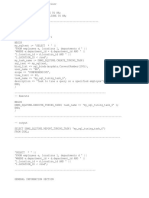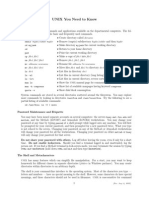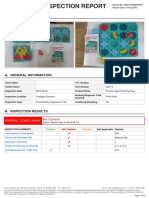Understanding Oracle QUERY PLAN - A 10 Minutes Guide
Understanding Oracle QUERY PLAN - A 10 Minutes Guide
Uploaded by
Vinay GoddemmeCopyright:
Available Formats
Understanding Oracle QUERY PLAN - A 10 Minutes Guide
Understanding Oracle QUERY PLAN - A 10 Minutes Guide
Uploaded by
Vinay GoddemmeOriginal Description:
Original Title
Copyright
Available Formats
Share this document
Did you find this document useful?
Is this content inappropriate?
Copyright:
Available Formats
Understanding Oracle QUERY PLAN - A 10 Minutes Guide
Understanding Oracle QUERY PLAN - A 10 Minutes Guide
Uploaded by
Vinay GoddemmeCopyright:
Available Formats
Understanding Oracle QUERY PLAN - A
10 minutes guide
Last Updated on Tuesday, 27 November 2012 12:50
Written by Akash Mitra
Confused about how to understand Oracle Query Execution Plan? This 10 minutes step by step primer is
the first of a two part article that will teach you exactly the things you must know about Query Plan.
What is Query Execution Plan?
When you fire an SQL query to Oracle, Oracle database internally creates a query execution plan in order to
fetch the desired data from the physical tables. The query execution plan is nothing but a set of methods
on how the database will access the data from the tables. This query execution plan is crucial as different
execution plans will need different cost and time for the query execution.
How the Execution Plan is created actually depends on what type of query optimizer is being used in your
Oracle database. There are two different optimizer options Rule based (RBO) and Cost based (CBO)
Optimizer. For Oracle 10g, CBO is the default optimizer. Cost Based optimizer enforces Oracle to generate
the optimization plan by taking all the related table statistics into consideration. On the other hand, RBO
uses a fixed set of pre-defined rules to generate the query plan. Obviously such fixed set of rules may not
always be able to create the plan that is most efficient in nature. This is because an efficient plan will
depend heavily on the nature and volume of tables data. Because of this reason, CBO is preferred over
RBO.
Understanding Oracle Query Execution Plan
But this article is not for comparing RBO and CBO (In fact, there is not much point in comparing these
two). This article will briefly help you understand,
1. How can we see Query Execution Plan
2. How do we understand (or rather interpret) the execution plan.
So lets begin. I will be using Oracle 10g server and SQL *Plus client to demonstrate all the details.
Oracle Full Table Scan (FTS)
Lets start by creating a simple product table with the following structure,
ID number(10)
NAME varchar2(100)
DESCRIPTION varchar2(255)
SERVICE varchar2(30)
PART_NUM varchar2(50)
LOAD_DATE date
Next I will insert 15,000 records into this newly created table (data taken from one of my existing product
table from one of my clients production environment).
Remember, currently there is no index on the table.
So we start our journey by writing a simple select statement on this table as below,
SQL> explain plan for select * from product;
Explained.
SQL> select * from table(dbms_xplan.display);
PLAN_TABLE_OUTPUT
----------------------------------------------------------
Plan hash value: 3917577207
-------------------------------------
| Id | Operation | Name |
-------------------------------------
| 0 | SELECT STATEMENT | |
| 1 | TABLE ACCESS FULL | PRODUCT|
-------------------------------------
Note
-----
- rule based optimizer used (consider using cbo)
Notice that optimizer has decided to use RBO instead of CBO as Oracle does not have any statistics for this
table. Lets now build some statistics for this table by issuing the following command,
SQL> Analyze table product compute statistics;
Now lets do the same experiment once again,
SQL> explain plan for select * from product;
Explained.
SQL> select * from table(dbms_xplan.display);
PLAN_TABLE_OUTPUT
-----------------------------------------------------
Plan hash value: 3917577207
-----------------------------------------------------
| Id | Operation | Name | Rows | Bytes |
-----------------------------------------------------
| 0 | SELECT STATEMENT | | 15856 | 1254K|
| 1 | TABLE ACCESS FULL | PRODUCT | 15856 | 1254K|
-----------------------------------------------------
You can easily see that this time optimizer has used Cost Based Optimizer (CBO) and has also detailed
some additional information (e.g. Rows etc.)
The point to note here is, Oracle is reading the whole table (denoted by TABLE ACCESS FULL) which is very
obvious because the select * statement that is being fired is trying to read everything. So, theres nothing
interesting up to this point.
Index Unique Scan
Now lets add a WHERE clause in the query and also create some additional indexes on the table.
SQL> create unique index idx_prod_id on product (id) compute statistics;
Index created.
SQL> explain plan for select id from product where id = 100;
Explained.
SQL> select * from table(dbms_xplan.display);
PLAN_TABLE_OUTPUT
---------------------------------------------------------
Plan hash value: 2424962071
---------------------------------------------------------
| Id | Operation | Name | Rows | Bytes |
---------------------------------------------------------
| 0 | SELECT STATEMENT | | 1 | 4 |
|* 1 | INDEX UNIQUE SCAN | IDX_PROD_ID | 1 | 4 |
---------------------------------------------------------
So the above statement indicates that CBO is performing Index Unique Scan. This means, in order to fetch
the id value as requested, Oracle is actually reading the index only and not the whole table. Of course this
will be faster than FULL TABLE ACCESS operation shown earlier.
Table Access by Index RowID
Searching the index is a fast and an efficient operation for Oracle and when Oracle finds the desired value
it is looking for (in this case id=100), it can also find out the rowid of the record in product table that has
id=100. Oracle can then use this rowid to fetch further information if requested in query. See below,
SQL> explain plan for select * from product where id = 100;
Explained.
SQL> select * from table(dbms_xplan.display);
PLAN_TABLE_OUTPUT
----------------------------------------------------------
Plan hash value: 3995597785
----------------------------------------------------------
| Id | Operation | Name |Rows | Bytes|
----------------------------------------------------------
| 0 | SELECT STATEMENT | | 1 | 81 |
| 1 | TABLE ACCESS BY INDEX ROWID| PRODUCT| 1 | 81 |
|* 2 | INDEX UNIQUE SCAN | IDX_PROD_ID | 1 | |
----------------------------------------------------------
TABLE ACCESS BY INDEX ROWID is the interesting part to check here. Since now we have specified select *
for id=100, so Oracle first use the index to obtain the rowid of the record. And then it selects all the
columns by the rowid.
Index Range Scan
But what if we specify a >, or between criteria in the WERE clause instead of equality condition? Like below,
SQL> explain plan for select id from product where id <10
Explained.
SQL> select * from table(dbms_xplan.display);
PLAN_TABLE_OUTPUT
---------------------------------------------
Plan hash value: 1288034875
-------------------------------------------------------
| Id | Operation | Name | Rows | Bytes |
-------------------------------------------------------
| 0 | SELECT STATEMENT | | 7 | 28 |
|* 1 | INDEX RANGE SCAN| IDX_PROD_ID | 7 | 28 |
-------------------------------------------------------
So this time CBO goes for an Index Range Scan instead of INDEX UNIQUE SCAN. The same thing will
normally happen if we use a between clause also.
Index Fast Full Scan
Now, lets see another interesting aspect of INDEX scan here by just altering the 10. Before we see the
outcome, just remind yourself that there are 15000 over products with their ids starting from 1 to
15000+. So if we write 10 we are likely to get almost 14990+ records in return. So does Oracle go for an
INDEX RANGE SCAN in this case? Lets see,
SQL> explain plan for select id from product where id>10;
Explained.
SQL> select * from table(dbms_xplan.display);
PLAN_TABLE_OUTPUT
------------------------------------------------
Plan hash value: 2179322443
--------------------------------------------------------
| Id | Operation | Name | Rows |Bytes |
--------------------------------------------------------
| 0 | SELECT STATEMENT | | 15849|63396 |
|* 1 | INDEX FAST FULL SCAN| IDX_PROD_ID| 15849|63396 |
---------------------------------------------------------
So, Oracle is actually using a INDEX FAST FULL SCAN to quickly scan through the index and return the
records from table. This scan is "quick" because unlike index full scan or index unique scan, INDEX FAST
FULL SCAN utilizes multiple-block input-output (I/O) whereas the formers utilizes single block I/O.
Note on QUERY PLAN
FTS or Full Table Scan
Whole table is read upto high water mark
Uses multiblock input/output
Buffer from FTS operation is stored in LRU end of buffer cache
Index Unique Scan
Single block input/output
Index Fast Full Scan
Multi block i/o possible
Returned rows may not be in sorted order
Index Full Scan
Single block i/o
Returned rows generally will be in sorted order
So I think we covered the basics of simple SELECT queries running on a single table. In the next article, We
will move forward to understand how does the query plan change when we join more than one table - that
is, we will know how to read the query plan when there is join between tables.
You might also like
- Oracle Database Administration Interview Questions You'll Most Likely Be Asked: Job Interview Questions SeriesFrom EverandOracle Database Administration Interview Questions You'll Most Likely Be Asked: Job Interview Questions SeriesRating: 5 out of 5 stars5/5 (1)
- Pro Oracle SQL Development: Best Practices for Writing Advanced QueriesFrom EverandPro Oracle SQL Development: Best Practices for Writing Advanced QueriesNo ratings yet
- High-Performance Oracle: Proven Methods for Achieving Optimum Performance and AvailabilityFrom EverandHigh-Performance Oracle: Proven Methods for Achieving Optimum Performance and AvailabilityNo ratings yet
- Oracle Solaris 11 System Virtualization Complete Self-Assessment GuideFrom EverandOracle Solaris 11 System Virtualization Complete Self-Assessment GuideNo ratings yet
- Oracle SOA BPEL Process Manager 11gR1 A Hands-on TutorialFrom EverandOracle SOA BPEL Process Manager 11gR1 A Hands-on TutorialRating: 5 out of 5 stars5/5 (1)
- Oracle 11g R1/R2 Real Application Clusters EssentialsFrom EverandOracle 11g R1/R2 Real Application Clusters EssentialsRating: 5 out of 5 stars5/5 (1)
- Oracle Database 11g - Underground Advice for Database Administrators: Beyond the basicsFrom EverandOracle Database 11g - Underground Advice for Database Administrators: Beyond the basicsNo ratings yet
- BMC Control-M 7: A Journey from Traditional Batch Scheduling to Workload AutomationFrom EverandBMC Control-M 7: A Journey from Traditional Batch Scheduling to Workload AutomationNo ratings yet
- Oracle 19c AutoUpgrade Best Practices: A Step-by-step Expert-led Database Upgrade Guide to Oracle 19c Using AutoUpgrade UtilityFrom EverandOracle 19c AutoUpgrade Best Practices: A Step-by-step Expert-led Database Upgrade Guide to Oracle 19c Using AutoUpgrade UtilityNo ratings yet
- Oracle TuningDocument7 pagesOracle Tuningnat732No ratings yet
- Performance and Tuning: Oracle Initialization Parameters Used in The Compilation of PLSQL UnitsDocument19 pagesPerformance and Tuning: Oracle Initialization Parameters Used in The Compilation of PLSQL UnitsYathindra sheshappaNo ratings yet
- Sangam 10 SQL 101 Query Execution PlansDocument12 pagesSangam 10 SQL 101 Query Execution PlanscpbbotNo ratings yet
- Les 05 ExplainDocument39 pagesLes 05 ExplaincomercialNo ratings yet
- Determine HWM and Reduce It by Shrink SpaceDocument6 pagesDetermine HWM and Reduce It by Shrink SpaceSiva KumarNo ratings yet
- How To Use SQL Tuning AdvisorDocument6 pagesHow To Use SQL Tuning AdvisorPankajkumar KapaseNo ratings yet
- Oracle NotesDocument49 pagesOracle NotesAbiramiNo ratings yet
- Oracle Database 19c Auto-IndexingDocument15 pagesOracle Database 19c Auto-IndexinglocutoNo ratings yet
- Adaptive Plans in Active Session History - Striving For OptimalDocument7 pagesAdaptive Plans in Active Session History - Striving For OptimalkruemeL1969No ratings yet
- PlansDocument0 pagesPlansDebashis MallickNo ratings yet
- Function Based Index and Column StatisticsDocument6 pagesFunction Based Index and Column StatisticsSaeed MeethalNo ratings yet
- Execution Plan ReadingDocument6 pagesExecution Plan ReadingMohammad NizamuddinNo ratings yet
- Interpreting Execution PlansDocument46 pagesInterpreting Execution PlansKhuất Đình CôngNo ratings yet
- Flashback Snapshot of SchemaDocument49 pagesFlashback Snapshot of SchemaSumit KNo ratings yet
- SQL Server QuestionsDocument10 pagesSQL Server QuestionsVeerendra ReddyNo ratings yet
- Oracle Data DictionaryDocument12 pagesOracle Data Dictionaryashish10mcaNo ratings yet
- Unselective IndexesDocument14 pagesUnselective IndexesJP VijaykumarNo ratings yet
- CDS Table Function Usage ScenarioDocument2 pagesCDS Table Function Usage Scenariosmitha.msNo ratings yet
- Oracle11g SlidesDocument319 pagesOracle11g SlidesVishnu TejNo ratings yet
- Oracle Histogram CheckingDocument6 pagesOracle Histogram Checkingashok nagaNo ratings yet
- Use Explain PlanDocument53 pagesUse Explain PlanRiaz SheikhNo ratings yet
- Chapter 4Document22 pagesChapter 4Jagdev Singh GrewalNo ratings yet
- Wrong ResultsDocument18 pagesWrong ResultsConstantin CaiaNo ratings yet
- Ebsom Dbim PDFDocument15 pagesEbsom Dbim PDFCuong Nguyen TanNo ratings yet
- Block Size Comparison1Document624 pagesBlock Size Comparison1gustavoloprestiNo ratings yet
- Rebuild IndexesDocument15 pagesRebuild IndexesSateesh Babu PinnojuNo ratings yet
- MV SQL Profile and IndexDocument7 pagesMV SQL Profile and IndexHeribertus BramunditoNo ratings yet
- DataRedaction Alex Zaballa GUORS 0Document52 pagesDataRedaction Alex Zaballa GUORS 0YawoviNo ratings yet
- What To Expect in Oracle 19cDocument42 pagesWhat To Expect in Oracle 19cwalterpotocki100% (1)
- Upgrade Oracle Ebs 12-1-3 To 12 22Document47 pagesUpgrade Oracle Ebs 12-1-3 To 12 22sanjayid1980No ratings yet
- Oracle 11g Results Cache: Dean Richards Senior DBA, Confio SoftwareDocument25 pagesOracle 11g Results Cache: Dean Richards Senior DBA, Confio Softwarechandu208No ratings yet
- February 2011 Bachelor of Computer Application (BCA) - Semester 4 BC0050 - Oracle & Distributed Databases - 4 CreditsDocument6 pagesFebruary 2011 Bachelor of Computer Application (BCA) - Semester 4 BC0050 - Oracle & Distributed Databases - 4 Creditskratnesh74No ratings yet
- SDSF New LabDocument48 pagesSDSF New LabcouchimanNo ratings yet
- Oracle SQL FAQ: What Is SQL and Where Does It Come From?Document8 pagesOracle SQL FAQ: What Is SQL and Where Does It Come From?jyotipc_mcaNo ratings yet
- Auditing in Oracle 10g Release 2Document9 pagesAuditing in Oracle 10g Release 2zareefNo ratings yet
- Oracle 11G: SQL Plan ManagementDocument35 pagesOracle 11G: SQL Plan Managementgurwinder_saini2003No ratings yet
- Dam Project ReportDocument35 pagesDam Project ReportMuhammad SardaarNo ratings yet
- SQLDocument3 pagesSQLNagarajuNo ratings yet
- Allrows Vs FirstrowsDocument7 pagesAllrows Vs Firstrowsanon_760342804No ratings yet
- Working With Postman PDFDocument7 pagesWorking With Postman PDFVinay GoddemmeNo ratings yet
- TambDocument6 pagesTambVinay GoddemmeNo ratings yet
- Diff AmpsDocument27 pagesDiff AmpsVinay GoddemmeNo ratings yet
- Andy Klise 4x4x4 GuideDocument2 pagesAndy Klise 4x4x4 GuideVinay Goddemme100% (1)
- Partner Path-sysOpsDocument2 pagesPartner Path-sysOpsVinay GoddemmeNo ratings yet
- Chapter 6Document31 pagesChapter 6Vinay GoddemmeNo ratings yet
- Stress ManagementDocument13 pagesStress ManagementVinay GoddemmeNo ratings yet
- Open Electives-List PDFDocument2 pagesOpen Electives-List PDFVinay GoddemmeNo ratings yet
- 3personality DevelopmentDocument12 pages3personality DevelopmentVinay GoddemmeNo ratings yet
- Leadership Module ContinuedDocument16 pagesLeadership Module ContinuedVinay GoddemmeNo ratings yet
- Fabrication of CMOS Integrated CircuitsDocument56 pagesFabrication of CMOS Integrated CircuitsVinay GoddemmeNo ratings yet
- Leadership: Building Blocks of LeadershipDocument19 pagesLeadership: Building Blocks of LeadershipVinay GoddemmeNo ratings yet
- UNIX You Need To Know: (Rev. Aug 14, 2009)Document4 pagesUNIX You Need To Know: (Rev. Aug 14, 2009)Vinay GoddemmeNo ratings yet
- InstrumentationDocument27 pagesInstrumentationVinay GoddemmeNo ratings yet
- Instance: What Is An Oracle Database?Document7 pagesInstance: What Is An Oracle Database?Vinay GoddemmeNo ratings yet
- L12 Rasler, Foreign Policy MakersDocument21 pagesL12 Rasler, Foreign Policy MakersAdriana AlarcónNo ratings yet
- Chapter 07Document33 pagesChapter 07Moktasid HossainNo ratings yet
- Constrictor GFRP PDFDocument4 pagesConstrictor GFRP PDFKevin PradanaNo ratings yet
- Advanced AlgorithmDocument5 pagesAdvanced AlgorithmJebah JayakumarNo ratings yet
- Four Broad Categories of ServicesDocument2 pagesFour Broad Categories of Servicesphoe_ko59% (27)
- Once Upon An IAS Exam by K. VijayakarthikeyanDocument118 pagesOnce Upon An IAS Exam by K. VijayakarthikeyanPRASANJIT MODAK76% (21)
- P&A System Solution Overview PAC-PulverizorDocument30 pagesP&A System Solution Overview PAC-PulverizorDenier RubianoNo ratings yet
- Baumer Encoder ITD 70 A 4 Y 7 GENERALDocument4 pagesBaumer Encoder ITD 70 A 4 Y 7 GENERALsandesh sawateNo ratings yet
- Build A Molecule: Teacher Guide: First TabDocument3 pagesBuild A Molecule: Teacher Guide: First TabIrvandar NurviandyNo ratings yet
- CA BA BS 480 Product IntroductionDocument33 pagesCA BA BS 480 Product Introductionvikasverma90No ratings yet
- Kapoor - ON TWO SEVENTEENTH CENTURY PERSIAN PAINTINGS DEPICTING COMETS OR FIREBALLSDocument22 pagesKapoor - ON TWO SEVENTEENTH CENTURY PERSIAN PAINTINGS DEPICTING COMETS OR FIREBALLSEric M GurevitchNo ratings yet
- End To End TestingDocument6 pagesEnd To End TestingEduardo777_777100% (1)
- RPV311 TM en 11.2aDocument302 pagesRPV311 TM en 11.2aThiago PradoNo ratings yet
- 5 - Q2 Creative WritingDocument16 pages5 - Q2 Creative WritingCharma Rose Tadeja100% (2)
- Telangana Board of Intermediate Education I Year Physics SyllabusDocument6 pagesTelangana Board of Intermediate Education I Year Physics SyllabusSrinuNo ratings yet
- As dc08 003 - 1Document5 pagesAs dc08 003 - 1Putra SeptiadyNo ratings yet
- Ballou 01Document25 pagesBallou 01rajuahmedt100% (1)
- Barangay Peace and Order and Public Safety PlanDocument3 pagesBarangay Peace and Order and Public Safety Plannorie garces100% (4)
- Mod MasterDocument4 pagesMod MasterNitin ChavanNo ratings yet
- DBMS: Notes Unit-4Document33 pagesDBMS: Notes Unit-4parth.2125ec1134No ratings yet
- Q RQ9194engDocument15 pagesQ RQ9194engdddcvNo ratings yet
- Toys Sample ReportDocument34 pagesToys Sample ReportraulNo ratings yet
- Unit 4 OSY PresentationDocument37 pagesUnit 4 OSY PresentationBeastboyRahul GamingNo ratings yet
- Characters: Unit ContentsDocument12 pagesCharacters: Unit ContentsAlvaro LoezNo ratings yet
- MR 2 2016 ProblemsDocument4 pagesMR 2 2016 Problemsuthso royNo ratings yet
- Book ItemDocument28 pagesBook ItemAnwesha PadhanNo ratings yet
- Resume Lucian Vidrascu Ict ExecutiveDocument3 pagesResume Lucian Vidrascu Ict ExecutiveLucian VidrascuNo ratings yet
- OutsourcingDocument22 pagesOutsourcingSanju DurgapalNo ratings yet
- Action Plan Template: Action Responsible Priority StatusDocument3 pagesAction Plan Template: Action Responsible Priority StatusSenapati Prabhupada DasNo ratings yet
- Iso 9283-1998Document66 pagesIso 9283-1998Biris GabrielNo ratings yet








































































































